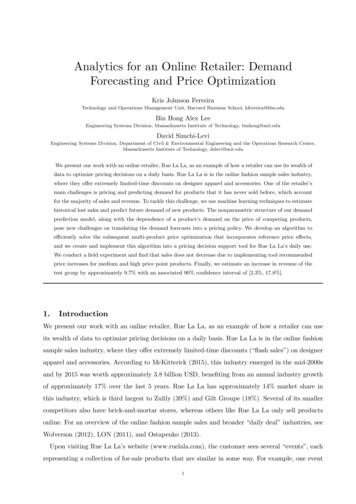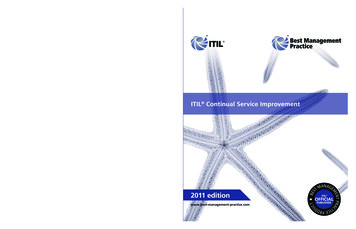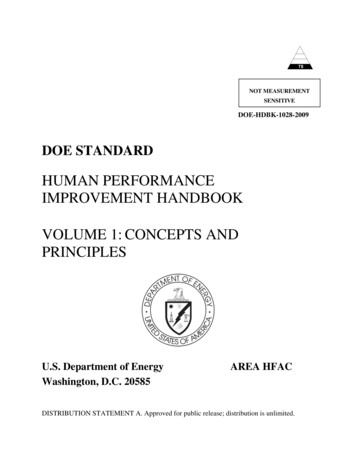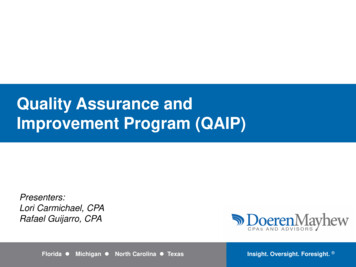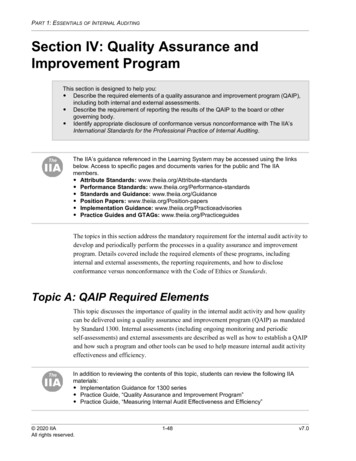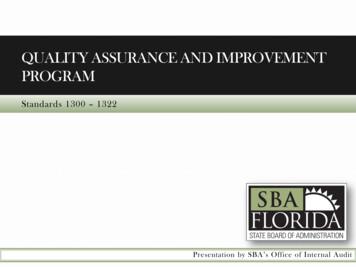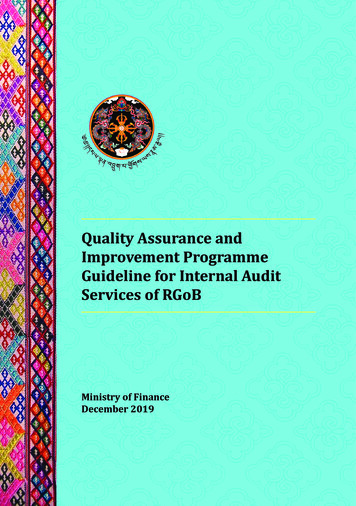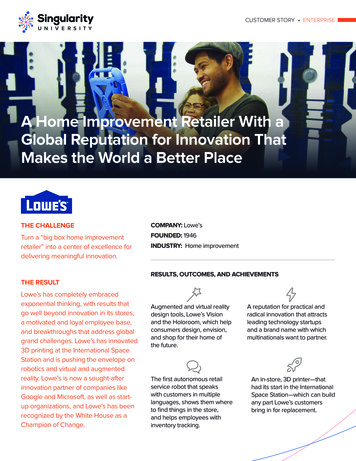
Transcription
CUSTOMER STORY ENTERPRISEA Home Improvement Retailer With aGlobal Reputation for Innovation ThatMakes the World a Better PlaceTHE CHALLENGECOMPANY: Lowe’sTurn a “big box home improvementretailer” into a center of excellence fordelivering meaningful innovation.FOUNDED: 1 946INDUSTRY: Home improvementRESULTS, OUTCOMES, AND ACHIEVEMENTSTHE RESULTLowe’s has completely embracedexponential thinking, with results thatgo well beyond innovation in its stores,a motivated and loyal employee base,and breakthroughs that address globalgrand challenges. Lowe’s has innovated3D printing at the International SpaceStation and is pushing the envelope onrobotics and virtual and augmentedreality. Lowe’s is now a sought-afterinnovation partner of companies likeGoogle and Microsoft, as well as startup organizations, and Lowe’s has beenrecognized by the White House as aChampion of Change. Augmented and virtual realitydesign tools, Lowe’s Visionand the Holoroom, which helpconsumers design, envision,and shop for their home ofthe future. The first autonomous retailservice robot that speakswith customers in multiplelanguages, shows them whereto find things in the store,and helps employees withinventory tracking. A reputation for practical andradical innovation that attractsleading technology startupsand a brand name with whichmultinationals want to partner. An in-store, 3D printer—thathad its start in the InternationalSpace Station—which can buildany part Lowe’s customersbring in for replacement.
How do you go from selling sheet rock and hammers totransforming Lowe’s, a Fortune 50 home improvementretailer, through exponential thinking? After launchingaugmented- and virtual reality-enhanced stores, the firstautonomous retail service robots, and the first store inspace, it may seem obvious to consider Lowe’s at theforefront of the corporate innovation discussion, but threeyears ago, these ideas seemed crazy.“We went from selling sheet rock andhammers to completely transformingthe entire company. Everyone nowsees what seemed insane at the timeand how this sets us up for the futurein a dramatic way. And it took onlythree years to get there.”— Kyle Nel, Founder and Executive Director ofLowe’s Innovation LabsIf it feels like the stuff of science fiction, that’s because it is. Lowe’s hasembraced a narrative-driven approach to innovation that is inspiringits more than 290,000 employees to think and behave differently. Ledby Kyle Nel, founder of Lowe’s Innovation Labs, this journey startedin 2013, two years after he joined the company to run internationalresearch. He challenged himself to create new ways of approachinginnovation at Lowe’s.“It wasn’t enough to have great ideas and insights,” notedNel. “I wanted to build stuff, and I was lucky because I waschallenged by a leader who said, ‘Tell me what it wouldlook like if we were really to create meaningful innovationinside the company.’”— Kyle NelAt the beginning, only Nel had the vision for what was possible atLowe’s. How could he parlay that vision into a reality to be shared?The first step was to find a community of like-minded thinkers whounderstood the benefits of using emerging technologies for bothbusiness growth and global good. He started by embedding for a yearat a dedicated Lowe’s Innovation Lab at Singularity University (SU). Infact, Lowe’s became a founding Corporate Member of SU Labs in 2014.Nel observed, “What I needed was a network, a community, a team.I found it at SU. I needed help to refine and scale my vision and to besurrounded by people who could impact me and help me feel like I waseither on the right track or not, and could explain why. Most innovationprograms or spaces are focused on two-by-two charts and a review ofcase studies having nothing to do with the unique challenges I faced atLowe’s. People attend these ‘innovation’ programs so they can check theinnovation box by completing the program. SU is different; everyone
that comes in the SU doors is self-selecting to be orientedtowards action. People are trying to partner, trying toco-create, pushing the technology frontier, and trying touplift to create a world of abundance.”Kyle Nel is a behavioral scientist, not a technologist. Thestructures he and his team have built to effect change atLowe’s rely on principles of behavioral change, includingthe power of story to engage and inspire, and of neuroscience to tap into unstated reactions to new experiences.Through this combination of narrative and neuroscience,Lowe’s has developed a reputation for leading corporateinnovation using exponential technologies such as artificialintelligence, robotics, virtual reality, additive manufacturing, and others.This methodology for understanding the future andchanging the way people think, feel, and act is no longersolely being used inside Lowe’s Innovation Labs. What wasinitially at the edge of the company is now a core strategicframework for the entire Lowe’s organization, and manyorganizations around the world are also using thisapproach—including Singularity University.Over the three years since Nel first embedded in hisSU Lab, he and others at Lowe’s have participated invirtually all of SU’s programs. Kyle’s activities haveincluded sponsoring an Impact Challenge in San Josethat challenged the SU community and customers toinnovate a solar cooker and water purifier using materialsfound at Lowe’s; participating in a Global Impact Challengewhere he met winning startups Fellow Robots and Made InSpace; keynoting at numerous SU Executive Programs, andSU’s Exponential Finance and Exponential ManufacturingSummits; and joining the SU faculty to share his expertiseon behavioral science as a cornerstone for innovation.“What I needed was a network, a community,a team. I found it at SU. I needed help to refineand scale my vision and to be surrounded bypeople who could impact me and help me feellike I was either on the right track or not, andcould explain why.”— Kyle NelScience Fiction Design InitiativeThe first challenge Nel faced was to get everyone at thecompany on the same page about the new future for Lowe’sand everyone’s role in helping to bring it about. After manyseemingly successful presentations, that ultimately didn’tresult in action, Nel decided to use a narrative-drivenapproach to innovation.Lowe’s provided science fiction writers with current trendand aggregated customer data and asked them to projectout five to ten years to describe what the retail store andthe home of the future would look like. The writers created stories of individual characters representing differentlifestyles and socioeconomic strata who would live in theworld they had imagined, which simplified and madeobvious the impact Lowe’s could have.This early effort resulted in a series of comic books thatwas presented to the executive team as the strategic planfor innovation. Among other scenarios, one comic bookfocused on a family renovating their home with the use ofaugmented and virtual reality. Presented just prior to thelaunch of the Oculus Rift Kickstarter campaign, these technologies were far from the minds of Lowe’s executives atthe time. But the story made this future tangible, and theirreaction was to say, “Go build it!” Since then, the Labs teamhas worked backwards to bring these and more stories tolife in a repeatable, proven process.SU has since developed the methodology and toolsdeveloped by Lowe’s Innovation Labs into Science FictionDesign Intelligence (SciFi D.I.), a program that helpscompanies turn science fiction into science fact. A keydifferentiator for SU, SciFi D.I. helps companies projectcurrent trends and exponential technologies out 15-20years, in order to plan prototypes of new solutions. SciFiD.I. is the ultimate in out-of-the-box thinking found at SU.
assessing measures like attention, cognition and emotionusing a combination of data from EEG headsets andeye tracking goggles, scientists can see how the brain isprocessing information using highly predictive correlativemodels. The technology serves as a diagnostic tool to createexperiences that make life simpler and more intuitive.Based on this research, the Labs team identified theLowe’s Vision experience delivered on the Tango platformas one of the most intuitive visualization experiencesavailable today.Holoroom and Beyond: Using Augmented,Virtual, and Mixed RealityThe first project that the Labs team launched to bring theoriginal narrative to life was the Holoroom, an augmentedreality application delivered via an iPad that allowed customers to enter a blank room and plan the specs and designof a home remodel. After testing the experience in Lowe’sCanada stores, the Holoroom evolved into a more immersive virtual reality experience that allowed customers todesign their space using an iPad, then view it in VR usingOculus Rift or Google Cardboard devices.Using the Holoroom, customers can now see and experience the layout in exquisite detail; they can walk up tocabinets to see the grain of wood on the various productsthey want to try out, and they can look under the cabinetsto see their finishes. This experience takes the uncertaintyout of the vast choice of materials that are available andenables people to share their vision. Customers can takea printout of the finished project with them, completewith pricing for all the elements they explore.Lowe’s has collaborated with Google to use its Tangoaugmented reality platform to launch Lowe’s Vision, asuite of applications for in-home visualization and in-storenavigation. Beyond visualization, Lowe’s has also createdHoloroom HowTo, a virtual reality clinic for do-it-yourselfhome improvement projects such as re-tiling bathrooms.The modules make it easier for customers to envision thefinal result, increase their retention of the steps involved,and help them feel significantly more confident abouttheir ability to do a good job.Throughout this journey, Lowe’s has partnered withNeurons, an applied neuroscience company, to evaluateconsumers’ unstated reactions to each experience. ByLoweBot with Fellow RobotsLowe’s has entered into productive partnerships with SUportfolio companies that have taken the retailer in excitingnew directions. “We were introduced to startup Fellow Robots at SU,” explained Nel. “Working together, we adaptedand extended their robotics to create the first retail robot,which we originally used at one of our Orchard SupplyHardware stores in San Jose, California in 2014. The original OSHbot served as a store directory that could recognizenatural language and tell or guide customers where to findwhat they were looking for in the store. Today, the programhas evolved to include eleven robots in Lowe’s stores, andthey can speak multiple languages. They’ve graduated tohelping employees complete inventory tracking within thestore, in addition to handling customer service.”Nel continued, “Our work in robotics has now also ledus to building carbon fiber rod exoskeletons with VirginiaTech that our employees are wearing to help with stockingshelves. When our employees bend over using the exoskeleton, it collects potential energy; when they release itby standing up, it turns it into kinetic energy for a 2X lift.There is no jerkiness in the movement because it is notbased on motors. With both of these programs, we’reshowing how innovation not only helps Lowe’s bottomline, but also benefits our employees.”
3D Printing of Parts at the International SpaceStation with Made In SpaceHelping to Solve the Safe Drinking WaterCrisis for 660 Million People in the WorldAnother challenge Lowe’s Innovation Labs tackled washow to advance real-time, local manufacturing. In an earlypilot conducted in partnership with Authentise, anotherSU portfolio company, customers could simply bring inan object, such as a broken or out of production part,and Lowe’s could digitally scan it for the customer to createa 3D model that could be used for printing, amongother applications. Broken parts could even be pieced backtogether. Customers could also modify and print objectsdesigned by Lowe’s, in just about any material they wanted.By partnering together, SU and Lowe’s developed aClean Water Challenge in San Jose, CA in 2015. The12-week challenge invited Bay Area citizen scientists anddo-it-yourselfers to design and build an affordable waterpurification device using common materials found inLowe’s home improvement stores. Judges and representatives from impact partners at Socialab and the International Water and Health Alliance selected one winner fromeach of two categories, solutions that cost more than 50to produce, or less than 50 to produce.In another partnership, Lowe’s exemplified moonshotthinking. “We learned a lot from partnering in 3D printingwith Made In Space, a connection we made at SU,” notedNel. “We essentially put a Lowe’s store in space at theInternational Space Station! We figured it would be agood test: if 3D printing could work flawlessly in theextreme conditions in space to produce parts that wearout or break, then it could also work in our stores.”Lowe’s and Made In Space have also brought forward amore holistic view of additive manufacturing that includeapplications like recycling. The two companies created aprototype demonstration of technology that would allowcustomers to bring in plastic bags or anything else madeof plastic they’re ready to discard, and recycle it into 3Dprinting filament to be used over and over and over againfor products like Lowe’s buckets. “We see things in aconstant state of transition, which helps the planet byreducing unnecessary waste,” said Nel. In 2016, the Obamaadministration recognized Lowe’s and Made In Space asChampions of Change for this effort.
Kyle Nel on theCritical Need to BeExponential and theValue of PartneringWith SU“A big part of working with SU andits global community is being ableto share your own experiences,as well as understand others’learnings and frameworks. WhenI’m at SU, I know I’m with people
Oculus Rift or Google Cardboard devices. Using the Holoroom, customers can now see and experi-ence the layout in exquisite detail; they can walk up to cabinets to see the grain of wood on the various products they want to try out, and they can look under the cabinets to see their finishes. This experience takes the uncertainty out of the vast choice of materials that are available and enables .
